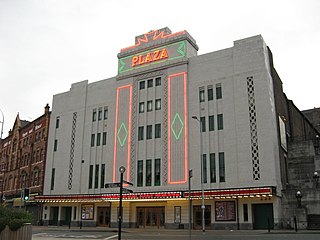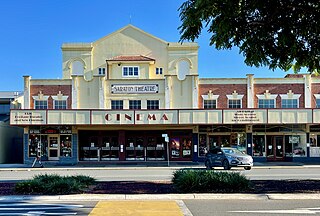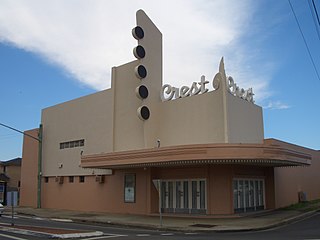
Covent Garden is a district in London, on the eastern fringes of the West End, between St Martin's Lane and Drury Lane. It is associated with the former fruit-and-vegetable market in the central square, now a popular shopping and tourist site, and with the Royal Opera House, itself known as "Covent Garden". The district is divided by the main thoroughfare of Long Acre, north of which is given over to independent shops centred on Neal's Yard and Seven Dials, while the south contains the central square with its street performers and most of the historical buildings, theatres and entertainment facilities, including the London Transport Museum and the Theatre Royal, Drury Lane.
Palladium is a chemical element with symbol Pd and atomic number 46.

The Odeon Luxe West End is a two-screen cinema on the south side of Leicester Square, London. It has historically been used for smaller film premieres and hosting the annual BFI London Film Festival. The site is on an adjacent side of the square to the much larger flagship Odeon Luxe Leicester Square.

Rundle Mall is a pedestrian street mall located in Adelaide, South Australia. It was opened as a pedestrian mall in September 1976 by closing the section of Rundle Street between King William Street and Pulteney Street, to vehicular traffic. The street continues as Rundle Street to the east and Hindley Street to the west.

The Rex is a cinema in the town of Berkhamsted, Hertfordshire, England. Designed in the art deco style by David Evelyn Nye in 1936, the cinema opened to the public in 1938. After 50 years of service, the cinema closed in 1988 and became derelict. The building was listed Grade II by English Heritage, and following a campaign to save the Rex by a local entrepreneur, the cinema re-opened to the public in 2004.

The Victoria Theatre is a heritage-listed former theatre at 8–10 Perkins Street, Newcastle, City of Newcastle, New South Wales, Australia. It was opened in 1876 and rebuilt during 1890–1891, and is the oldest theatre still standing in New South Wales. It was added to the New South Wales State Heritage Register on 27 August 1999.
Oldham Coliseum Theatre is a theatre in Oldham, Greater Manchester, England. Located on Fairbottom Street in the town centre, it opened in 1887 as the Colosseum, a reconstruction of an 1885 wooden circus building, has since been rebuilt as a masonry building, and in the 20th century was a music hall and briefly a cinema before reverting to being a repertory theatre. It was closed in 2023 and was to be redeveloped, but is to reopen in late 2025 after refurbishment.

The State Theatre is a 2034 seat heritage listed theatre located at 47–51 Market Street, in the Sydney central business district in the City of Sydney local government area of New South Wales, Australia. The theatre was designed by Henry Eli White with assistance from John Eberson and built between 1926 and 1929. It hosts film screenings, live theatre and musical performances, and since 1974 it has been the home of the annual Sydney Film Festival. It is also known as State Building and Wurlitzer Organ. The property is privately owned. It was added to the New South Wales State Heritage Register on 2 April 1999.

The Plaza is a Grade II* listed art deco single-screen cinema and theatre in Stockport, Greater Manchester, England. It opened in 1932, its construction having involved the excavation of the sandstone cliff behind it. After an initial closure in 1966 and a subsequent period in use as a bingo hall by Rank Leiure, it has now been restored as a cinema and theatre, showing films and staging live shows.

Newport Market is a traditional Victorian indoor market in Newport, South Wales. It is a Grade II-Listed building in the city centre, owned and operated by Newport City Council. The main structure, completed in 1889, is an early example of a large-span cast iron-frame building featuring a glazed barrel roof. The market re-opened in March 2022 as a multi-purpose food, retail and office space following a £5–6 million renovation.

Grote Street is a major street running east to west in the western half of Adelaide city centre, South Australia. It is on the northern border of Chinatown and the Adelaide Central Market, and is a lively centre for shopping and restaurants. The historic Her Majesty's Theatre is located here.

John Stanley Coombe Beard FRIBA, known professionally as J. Stanley Beard, was an English architect known for designing many cinemas in and around London.

The New Theatre Royal is a Victorian Grade II* listed theatre in the heart of Portsmouth, England, with a capacity of 648. The theatre building was constructed in 1854 as Landport Hall. It was converted to a theatre two years later. It was rebuilt in 1884 by Charles J. Phipps and again in 1900 by Frank Matcham.

Paragon Theatre is a heritage-listed cinema and theatre at 75 Churchill Street, Childers, Bundaberg Region, Queensland, Australia. It was designed by Arthur Robson and built in 1927 by P Mellefont, Jnr. It was added to the Queensland Heritage Register on 28 April 2000.

Corn exchanges are distinct buildings which were originally created as a venue for corn merchants to meet and arrange pricing with farmers for the sale of wheat, barley, and other corn crops. The word "corn" in British English denotes all cereal grains, such as wheat and barley. With the repeal of the Corn Laws in 1846, a large number of corn exchanges were built in England, particularly in the corn-growing areas of Eastern England.

Saraton Theatre is a heritage-listed theatre at 95 Prince Street, Grafton, Clarence Valley Council, New South Wales, Australia. It now operates both as a cinema and a venue for live performances. The original 1926 building was designed by F. J. Board and built by J. Walters, while the 1940 interior was designed by George Rae and built by Goddard & Goddard. The property is owned by Notaras Bros Entertainment Pty Ltd. It was added to the New South Wales State Heritage Register on 9 June 2000.

The Scone Civic Theatre is a heritage-listed cinema at 144 Kelly Street, Scone, Upper Hunter Shire, New South Wales, Australia. It was designed by Guy Crick and Bruce Furse and built from 1937 to 1938 by Mr A. F. Little. The property is privately owned. It was added to the New South Wales State Heritage Register on 21 February 2003.

Crest Theatre is a heritage-listed former cinema and ballroom and now community centre at 157 Blaxcell Street, Granville, City of Parramatta, New South Wales, Australia. It was designed by Cowper and Murphy and Associates and built in 1948 by A. W. Edwards Pty Ltd. It is also known as Hoyts Crest Theatre. Following its purchase by the Australian Blouza Association, it has been referred to as Blouza Hall. It was added to the New South Wales State Heritage Register on 1 August 2003.

Roxy Theatre is a heritage-listed former theatre at 65–69 George Street, Parramatta, City of Parramatta, New South Wales, Australia. It was designed by Moore & Dyer in association with Herbert & Wilson. It is also known as Roxy Spanish Theatre, Hoyts Roxy Centre, Village Roxy 3 and The Roxy. It was added to the New South Wales State Heritage Register on 2 April 1999.

The Alexandra Theatre is an entertainment complex in Market Street, Newton Abbot, Devon, England. The structure, which was commissioned as a corn exchange and is currently used as a cinema, is a Grade II listed building.


















